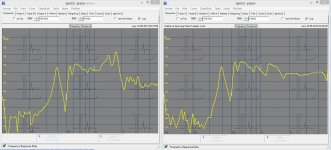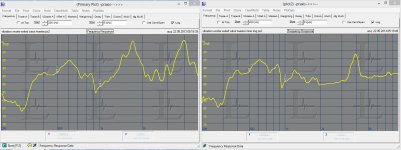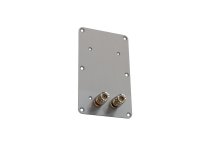What speakers do you use ? ?
Nothing much at the moment, I have some prototypes in the shop which may be finished someday.... Left all my high end gear when I moved from NYC to Ohio in 2003. I have a couple cheap pairs of speakers: Zaph's BAMTMs* and Berhinger 2031Ps. The treble on the BAMTMs is pleasantly not fatiguing but the bass is lacking and they can't play loud and clean (choose one or the other). The 2031Ps have some subtle flaws and I'm not quite happy with them - if I figure out exactly whats wrong with them (and perhaps how to improve them) I should make a post somewhere... They're certainly better than say, some typical Best Buy speakers though 🙂
But, I did spend several days auditioning many moderate to high-end speakers and only found one pair I really liked (most of them gave me a headache within a few minutes of listening). The ones I liked were the Madrigal Revel Ultima Salons (the not the version 2). And before I listened to those I imagined that I did not like metal dome tweeters - I am surprised that my ears could overcome pre-existing bias.
* I use the silk dome Seas tweeters rather than the metal ones that Zaph specifies, this is because I had also wanted to try his "Waveguide TMMs" some day.
Last edited:
I won't argue that in your thread, but - would you not agree that the significance is of the resistor is much smaller than the difference between two different models of drivers
What speakers do you use ?
I agree, when the speaker is not well engineered no exotic component can help.
Nothing much at the moment
The point of Joachim question was, where do you stand? If your speaker is full of mistakes then you're right that a resistor is insignificant. If your speaker is optimally engineered, then a resistor can become a weak point and is significant.
Joachim,
Just wanted to thank you (and Jeff Bagby for a similar build thread at Meniscus). Sartori tweeter sounds terrific and mates beautifully with the Usher woofers. In hog heaven...😀
Just wanted to thank you (and Jeff Bagby for a similar build thread at Meniscus). Sartori tweeter sounds terrific and mates beautifully with the Usher woofers. In hog heaven...😀
When i read this i got an idea. I have an accelerometer that i can fit to the silver outer ring and to the black inner part of the Satori tweeter.
Lets see if i can find some reduction of resonance.
Lets see if i can find some reduction of resonance.
Good idea. Still loving these tweeters regardless of what the decoupling ring's effect or lack thereof.When i read this i got an idea. I have an accelerometer that i can fit to the silver outer ring and to the black inner part of the Satori tweeter.
Lets see if i can find some reduction of resonance.
They are certainly very good. The best ring radiator i found this far.
By using a ferrite magnet they are also economical but of cause not dirt cheep.
By using a ferrite magnet they are also economical but of cause not dirt cheep.
Joachim, very interesting. Thank you.
So the excitation is voltage input to the crossover, and both woofer and tweeter are inputing inertial vibration with the woofer pressurizing the cabinet. Yes? I am guessing the inertial input from the tweeter dome is negligible.
The outer ring shows higher vibration below the crossover frequency and lower vibration above. The inner ring shows the opposite. Yes? If the inner and outer ring were "decoupled" (connected) by a spring, we could expect a resonance between them, which must be well damped. Such a resonance would form a second order low pass filter to reduce tweeter (inner ring) motion above the resonant frequency. This behavior is not obvious, but could the "decoupling" be tuned at about 1500 Hz?
Is the tweeter backed by its own sub-enclosure? Or is the tweeter subjected to pressure forces in side the cabinet from the woofer?
These measurements are difficult to interpret. I suspect that the people at SB Acoustics must understand these, and have given it much thought.
Regards,
Charlie
So the excitation is voltage input to the crossover, and both woofer and tweeter are inputing inertial vibration with the woofer pressurizing the cabinet. Yes? I am guessing the inertial input from the tweeter dome is negligible.
The outer ring shows higher vibration below the crossover frequency and lower vibration above. The inner ring shows the opposite. Yes? If the inner and outer ring were "decoupled" (connected) by a spring, we could expect a resonance between them, which must be well damped. Such a resonance would form a second order low pass filter to reduce tweeter (inner ring) motion above the resonant frequency. This behavior is not obvious, but could the "decoupling" be tuned at about 1500 Hz?
Is the tweeter backed by its own sub-enclosure? Or is the tweeter subjected to pressure forces in side the cabinet from the woofer?
These measurements are difficult to interpret. I suspect that the people at SB Acoustics must understand these, and have given it much thought.
Regards,
Charlie
I measured the tweeter without a crossover in a test cabinet, woofer not connected. I will pupish more details.
I did not comment on the measurements by decission.
I did not comment on the measurements by decission.
The woofer is not driven, this was a good choice as it is simpler. The decoupling corner frequency is at about 1800 Hz or maybe two similar modes at 1500 and 1800. The damping at 1800 Hz is fairly low, so maybe not too much hysteresis.
Another informative measurement would be with woofer driven only. Presumably we would see similar result? Reciprocity, if sufficiently linear.
Wise not to comment, as it is easy to jump to (perhaps wrong) conclusions based on so little information.
The relevance of these acceleration measurements depends upon their magnitude (in say m/sec^2) compared to tweeter diaphragm acceleration at the same drive voltage. Yes?
Charlie
Another informative measurement would be with woofer driven only. Presumably we would see similar result? Reciprocity, if sufficiently linear.
Wise not to comment, as it is easy to jump to (perhaps wrong) conclusions based on so little information.
The relevance of these acceleration measurements depends upon their magnitude (in say m/sec^2) compared to tweeter diaphragm acceleration at the same drive voltage. Yes?
Charlie
Interesting. Praxis lets you plot both measurements in different colors - would be easier to compare.
The 1800 Hz peak reduced by 25dB, the 3900 Hz by maybe 8 dB. The transducer resonance is well above this frequency, i assume?
The 1800 Hz peak reduced by 25dB, the 3900 Hz by maybe 8 dB. The transducer resonance is well above this frequency, i assume?
These measurements are difficult to interpret.
I did not comment on the measurements by decission.
Yeah. Doesn't look good. But if posted side by side with similar ring radiators, may be worth a few hundreds words.
I posted the measurements side by side because my Praxis software has a bug and i can not do overlay. I will talk to Bill Waslo how to solve that.
Yes, i could make a comparison to a tweeter that does not have the decoupling ring.
Anyway, it has a positive effect.
Anyway, it has a positive effect.
I hope this discussion is constructive for this thread, and not just an attempt to reverse-engineer the SB Acoustics design.
My assumption that the purpose of the decoupling mount is to isolate the tweeter dome from cabinet vibration must surely be false. The coupling would need to be far softer for that purpose, with a corner frequency below the woofer's Fc. Perhaps the purpose is to reduce spurious vibration, radiation and energy storage in the tweeter structure. Note the acceleration spectrum is significantly flat with frequency (which would imply mass-controlled motion).
Since these measurements are made at one location only, we don't yet know how it changes around the surface of the face plate inner and outer rings. This is a deep subject, and a laser vibrometer would be most helpful...
But, yes, it would be interesting to see how a similar tweeter of conventional construction behaves.
Charlie
My assumption that the purpose of the decoupling mount is to isolate the tweeter dome from cabinet vibration must surely be false. The coupling would need to be far softer for that purpose, with a corner frequency below the woofer's Fc. Perhaps the purpose is to reduce spurious vibration, radiation and energy storage in the tweeter structure. Note the acceleration spectrum is significantly flat with frequency (which would imply mass-controlled motion).
Since these measurements are made at one location only, we don't yet know how it changes around the surface of the face plate inner and outer rings. This is a deep subject, and a laser vibrometer would be most helpful...
But, yes, it would be interesting to see how a similar tweeter of conventional construction behaves.
Charlie
In the SB29 ring radiator I've noticed a fragile frontplate. Thin plastic with 3 bolts. When bending it littlebit there is "noice"... hmmm
And the back-cup have a clear plastic "plonk" when tapping on it with my fingers.
Solved most of it by using bitumen matt on back-cup and router deeper so i could fit the same gasket/sealing adhesive as i have around my windows. Have not measured but it decouple for sure. The hole tweeter is "floating". Works great.
Very good that most if this been taken care of here in this Satori. This will be my next upgrade when money allows.
And the back-cup have a clear plastic "plonk" when tapping on it with my fingers.
Solved most of it by using bitumen matt on back-cup and router deeper so i could fit the same gasket/sealing adhesive as i have around my windows. Have not measured but it decouple for sure. The hole tweeter is "floating". Works great.
Very good that most if this been taken care of here in this Satori. This will be my next upgrade when money allows.
Last edited:
Also it sits in a separate chamber and about 1-2 liters of sand in another chamber around that.
Good way of doing it. In the original Audio Physic Virgo i had a decoupled tweeter on 3 pieces of foam rubber. It made a difference to the sound.
I just would like to remind everybody that the official Satori Monitor Kit needs an
8 OHM WOOFER, and NOT a 4 OHM WOOFER:
I do not know why, but there was some confusion about it.
SB is now working out the details, for example how to fit the crossover.
The space inside the monitor is spars so we decided on a aluminum terminal at the back that also carries the crossover.
Cabinets are ordered and will be available soon.
I just would like to remind everybody that the official Satori Monitor Kit needs an
8 OHM WOOFER, and NOT a 4 OHM WOOFER:
I do not know why, but there was some confusion about it.
SB is now working out the details, for example how to fit the crossover.
The space inside the monitor is spars so we decided on a aluminum terminal at the back that also carries the crossover.
Cabinets are ordered and will be available soon.
Attachments
- Home
- Vendor's Bazaar
- SB Acoustics Satori Monitor


